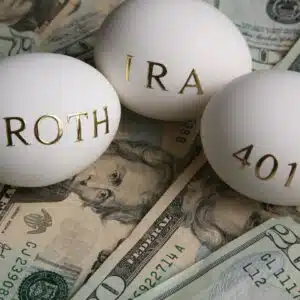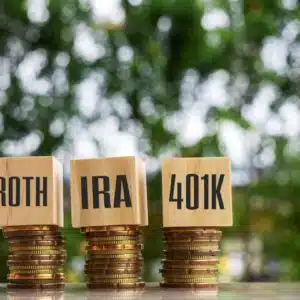Welcome to another Ask GFC! If you have a question that you want answered you can ask it here.
If your questions get featured on GFC TV or the GFC Podcast, you are the lucky recipient of a copy of my best selling book, Soldier of Finance, and a $50 Amazon gift card.
So what are you waiting for? Ask your question now!
The 401(k) plan is one of the greatest innovations ever developed for working Americans to save and invest money for retirement. But 401(k) plans are primarily for salaried employees – where does that leave self-employed?
This is another great topic inspired by a question from a GFC TV viewer named Shane:
I’m self employed so I don’t have they luxury of having a 401k. I do have a Roth that I contribute the maximum amount to each year, but my question is are there other ways that I can put money away for the future that will give me a decent return? Shane G.
There’s no need to beat around the bush on this topic. Yes, Shane, there are 401(k) equivalents for the self-employed. There are of course traditional and Roth IRA plans that you can participate in, but there are other retirement plans available to the self-employed that look a lot more like a 401(k) plan.
There are three that are worthy of a deep discussion.
SIMPLE IRA
A SIMPLE IRA is a retirement plan that is available for small businesses with fewer than 100 employees. Much like an IRA (and it is an IRA), contributions to the plan are tax-deductible, and investment earnings accumulate on a tax-deferred basis. You can begin making withdrawals at age 59 1/2, but if you take distributions before that age they will be subject to regular income tax, plus a 10% early withdrawal penalty.
In order to qualify to make a contribution, you must earn a minimum of $5,000 in either of the past two years.
For 2025, the maximum contribution is $16,000, or $19,500 if you are 50 or older. You can contribute 100% of your earnings up to those limits. So if you earn $16,000, you can contribute $16,000.
As an employer, you’ll have to make either a 3% matching contribution or a 2% nonelective contribution. In either case, the employer contribution percentage must be based on the employee’s compensation, which is your compensation if you’re self-employed.
As an example, if your self-employment income is $100,000, you can contribute $16,000 as an employee, but then provide yourself with an employer match of $3,000. That will be a total of $18,500. It’s not as generous as an employer-sponsored 401(k) plan, but it’s a lot better than what you can do with an IRA.
One of the biggest advantages of the SIMPLE IRA is that you do not have to file a plan-specific tax return with the IRS. That makes management of the plan much easier. You can also maintain the plan through a brokerage of your choice. It can be a self-directed account, enabling you to maintain the maximum number of investment options.
SEP IRA
The long version of this plan is Simplified Employee Pension Plan, and like a SIMPLE plan, it is a type of IRA. It is designed as a retirement plan for self-employed individuals and for small business owners and their employees.
As is the case with an IRA, your contributions are tax-deductible, and your investment earnings accumulate on a tax-deferred basis. You can begin taking distributions from a plan after age 59 1/2, at which time the withdrawals will be subject to regular income tax. If you take distributions before this age, you’ll have to pay regular income tax, plus a 10% early withdrawal penalty.
The maximum that you can contribute to a SEP IRA for 2025 is 25% of compensation, to a maximum of $69,000. If you have employees, then each employee must open an individual SEP IRA account.
The plan is easy to setup, and easy to administer and maintain. You can set it up through popular investment brokerage accounts, as a self-directed plan. As the employer, you will be required to complete IRS Form 5305 SEP. However, the form must be maintained for your records, but you are not required to make an annual tax filing with the IRS.
Solo 401(k)
This is probably the best retirement plan option for the self-employed, largely because it virtually is a 401(k) plan. It’s just a 401(k) plan for a single individual, as the name implies. However, a sole proprietor can actually hire his or her spouse, and still be eligible for the plan.
With a solo 401(k) plan, you act as both employer and employee in the arrangement. That also gives you an opportunity to make two distinct contributions to the plan.
As an employee, you can contribute up to $23,000 per year, or $30,500 if you’re age 50 or older. These are the same contribution limits that apply to employees under a traditional 401(k) plan. One of the really nice benefits to a solo 401(k) is that you can literally contribute up to 100% of your income in order to reach those limits. (You can actually do this under employer-sponsored 401(k) plans, but most employers put a percentage limit on your contributions.)
But then you can also make a contribution as the employer. This is referred to as an employer nonelective contribution. It’s so named because it is based on a percentage of your net business income, and not a flat dollar amount. You can contribute up to 25% of total net business income to the plan, as the employer.
(In regard to business income, the IRS has a complicated worksheet to make this determination in Chapter 5 of IRS Publication 560, so if you have a solo 401(k) I’d strongly recommend a paid tax preparer, preferably a CPA.)
This is a bit complicated, I know! So let’s walk through an example so that you can see how it works.
You have a total net business income of $100,000. As an employee, you make your $23,000 contribution to your solo 401(k). As an owner, you can make an employer nonelective contribution of $25,000 – that’s $100,000 times 25%. The total contribution to the plan will be $47,500 for the year.
Now we’re getting to the point where you can see the solo 401(k) is a much more generous plan than the employer-sponsored variety.
There is an absolute limit on how much you can contribute to a solo 401(k) plan. For 2025, it’s $69,000, or $76,500 if you’re age 50 or older. And since those limits are also the maximum that you can contribute to all retirement plans of any type, it will have to be reduced by any amounts contributed to other retirement plans that you have, whether those contributions have been made by you personally or by an employer.
Which Is the Right Self-Employed Retirement Plan for You?
Any of the three plans will enable you to put away a lot more money for retirement than you could with just an IRA account. The easiest plan to administer will be the SIMPLE IRA. But if you are looking for maximum contributions, both the SEP IRA and the Solo 401(k) provide greater amounts, consistent with – or exceeding – what an employee could contribute to an employer sponsored 401(k) plan.
My vote goes to the Solo 401(k). I say that because it offers the ability to achieve the greatest contribution amount for the lowest income. I gave the example of being able to make a $47,500 contribution on a $100,000 income with a Solo 401(k). On the same income, you would be limited to 25%, or $25,000 with a SEP IRA. This clearly favors the Solo 401(k).
Whichever one you choose, you will still come a lot closer to an employer-sponsored 401(k), and do a lot better than you would with a regular IRA.
Comparing Self-Employed Retirement Plans: A Quick Guide
| Retirement Plan | Eligibility | Contributions (2023) | Tax Benefits | Employer Contribution |
|---|---|---|---|---|
| SIMPLE IRA | <100 Employees | $16,000 ($19,500 if 50+) | Tax-Deductible, Tax-Deferred | 3% Match or 2% Nonelective |
| SEP IRA | Self-Employed & Small Businesses | Up to 25% Of Income (Max $69,000) | Tax-Deductible, Tax-Deferred | Employee Accounts |
| Solo 401(k) | Self-Employed (Including Spouse) | $23,000 ($30,500 if 50+) + up to 25% Of Income | Tax-Deductible, Tax-Deferred | Employee and Employer |
The Bottom Line – Ask GFC 007: Are There 401(k) Equivalents for the Self-Employed?
Self-employed individuals have several retirement savings options that provide similar tax advantages and retirement security to traditional 401(k) plans. These alternatives include the SIMPLE IRA, SEP IRA, and Solo 401(k). Each plan has its own set of rules and contribution limits, allowing self-employed individuals to tailor their retirement savings strategy to their unique financial situation. While all three plans offer substantial benefits compared to regular IRAs, the Solo 401(k) stands out as an excellent choice due to its ability to maximize contributions, making it a top pick for self-employed individuals looking to secure their financial future in retirement.








Great info. I do worry that as more and more people start going into business for themselves not many are remembering to properly save for their retirement. That’s why it’s definitely good to know all of these options.
That’s a good point Jonathan. When people start a business they can get so caught up in the details of the business that they forget about long-term financial planning. And it’s always best to set up some sort of retirement plan as soon as possible, even if you can only fund it with a little bit of money at the beginning. You’ll still be building momentum, and that’s sooooo important!